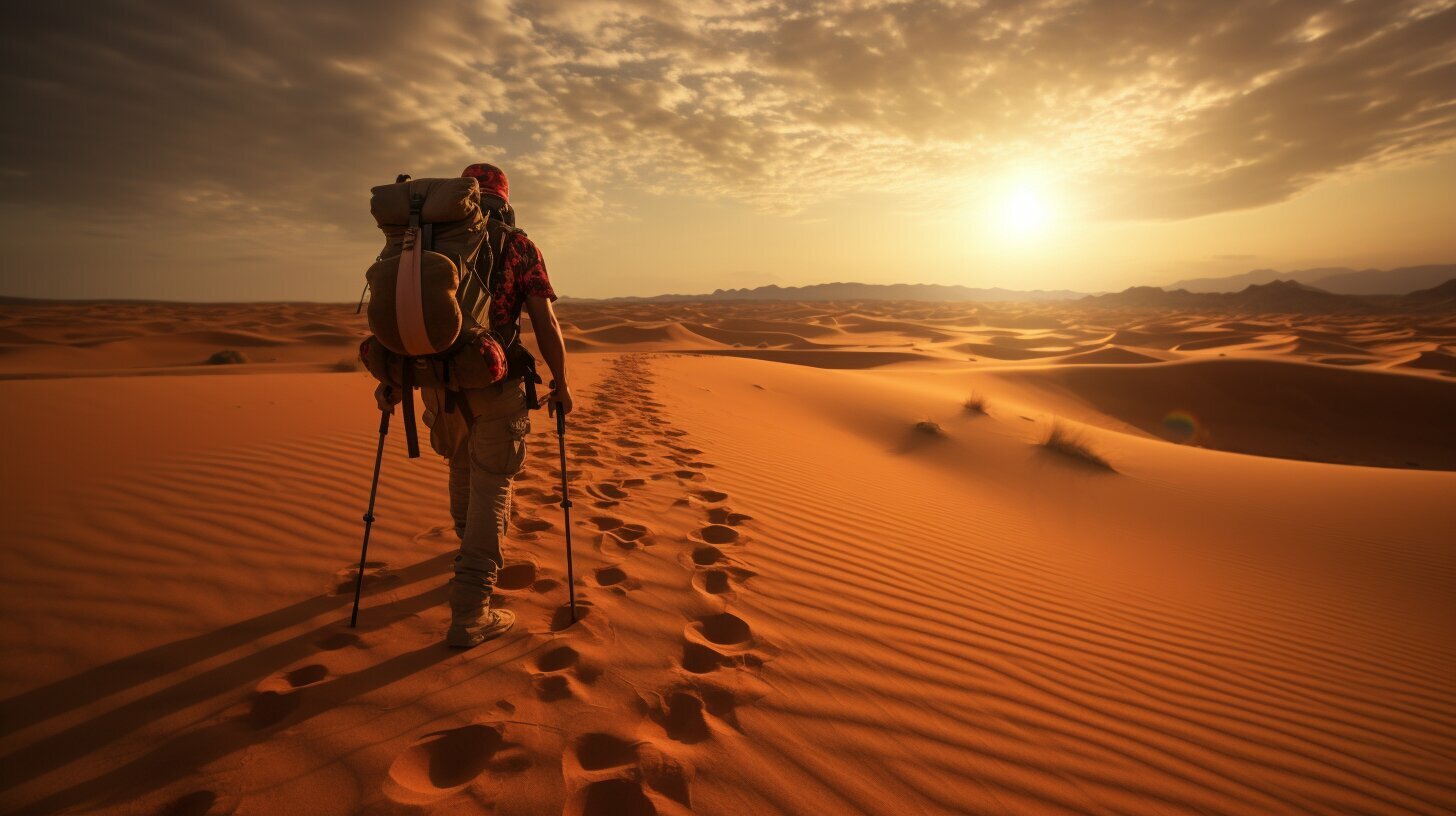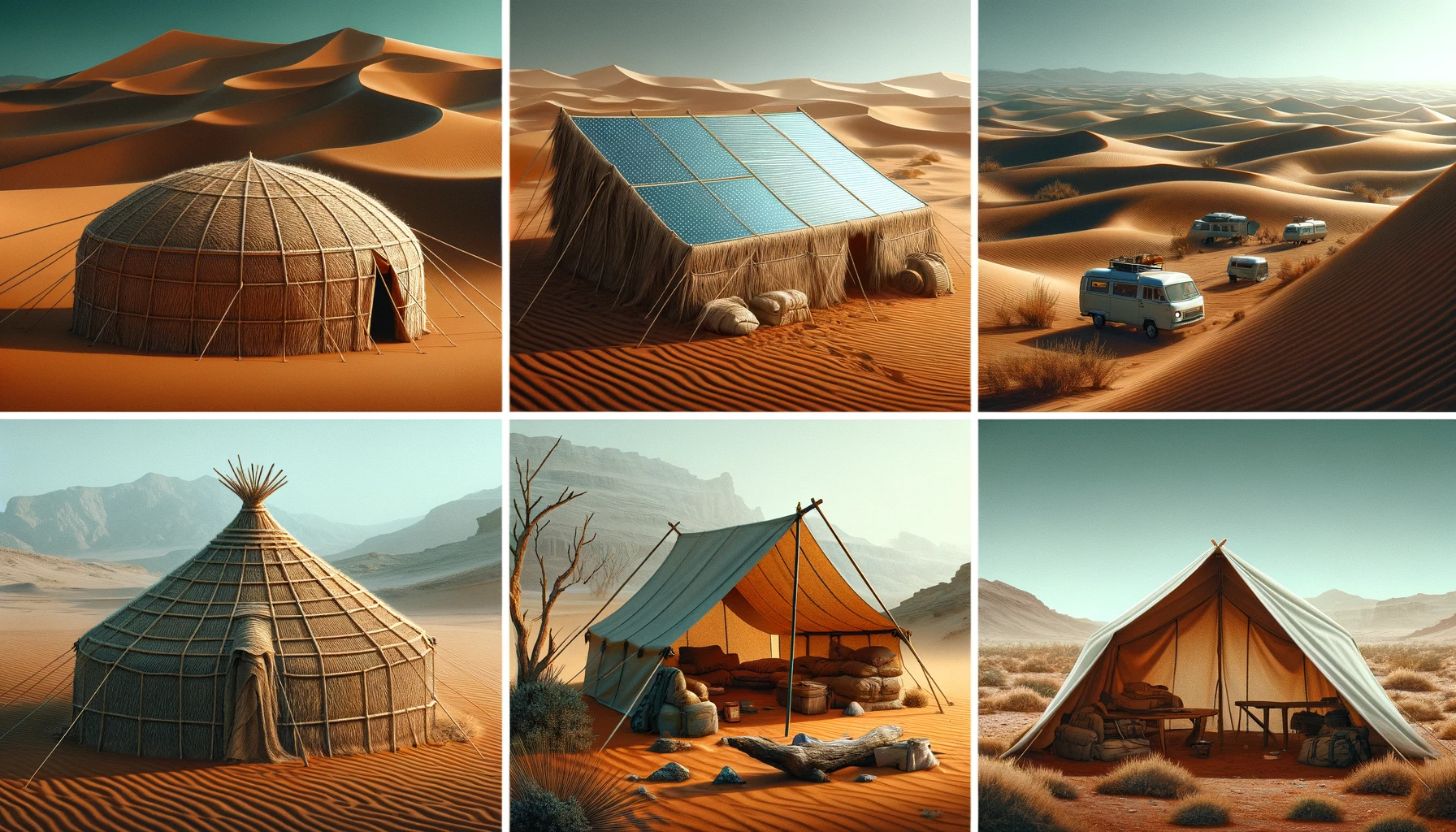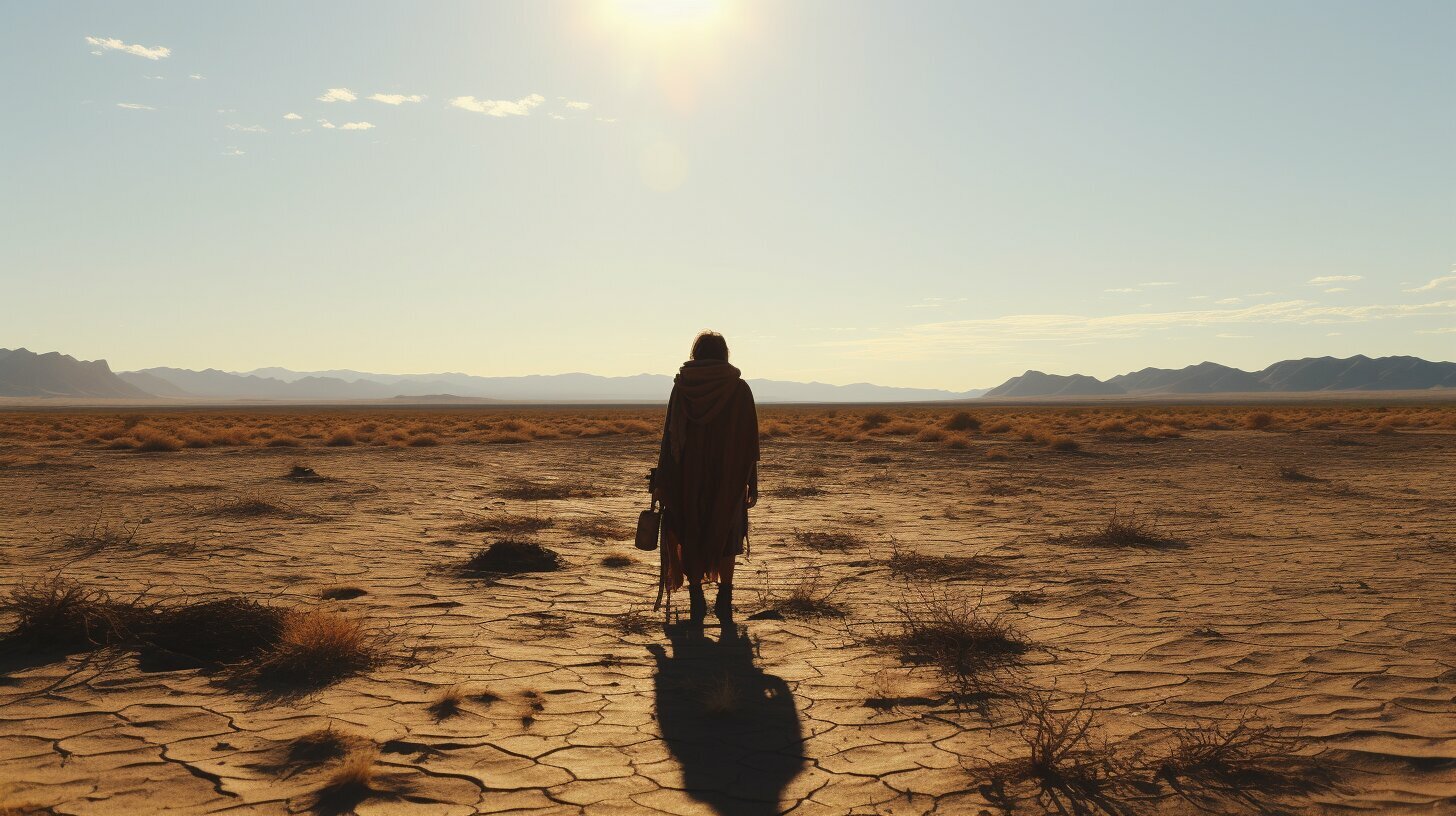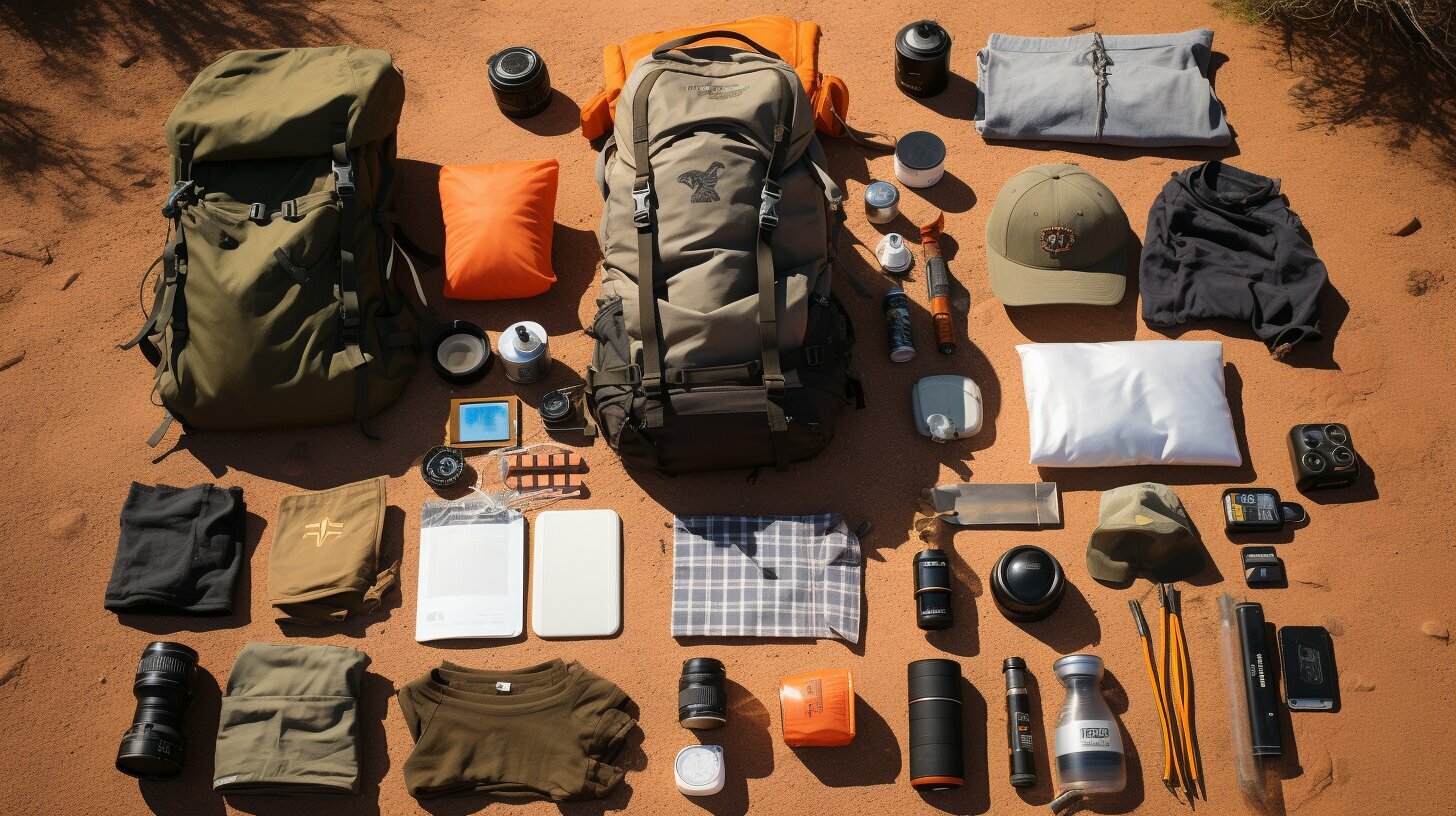When it comes to traveling in the desert, mastering navigation techniques is essential for your survival. The harsh, arid terrain can be disorienting and dangerous if you don’t know how to navigate it properly. In this article, we will provide you with an ultimate survival guide to mastering desert navigation techniques.
Key Takeaways
- Mastering desert navigation techniques is essential for survival in arid environments
- Understanding the desert environment and reading the terrain is crucial for successful navigation
- Using landmarks, natural cues, compasses and maps, equipment, planning, and backtracking techniques can help you navigate safely and confidently in the desert
- Staying hydrated, conserving energy, and maintaining orientation are important tips for successful desert travel
Understanding the Desert Environment
If you want to master desert navigation techniques, it’s important to start by understanding the unique challenges and features of the desert environment. This knowledge will help you better prepare for your journey and make informed decisions while navigating.
Deserts are characterized by their arid climate, lack of water sources, and extreme temperatures. Temperature fluctuations between day and night can be significant, so it’s important to pack clothing that will keep you warm during cold nights and cool during hot days. Additionally, the lack of shade in the desert can quickly lead to dehydration, making it crucial to bring ample water or have a plan for finding and purifying water sources.
Disclosure: When you buy through links on our site, we may earn an affiliate commission.
Another key aspect of the desert environment that impacts navigation is its lack of distinctive features. Unlike forests or mountains, deserts often lack easily recognizable landmarks, making it difficult to stay oriented. However, the desert is not featureless. Rock formations, vegetation, and other natural cues can be used for navigation if you know what to look for.
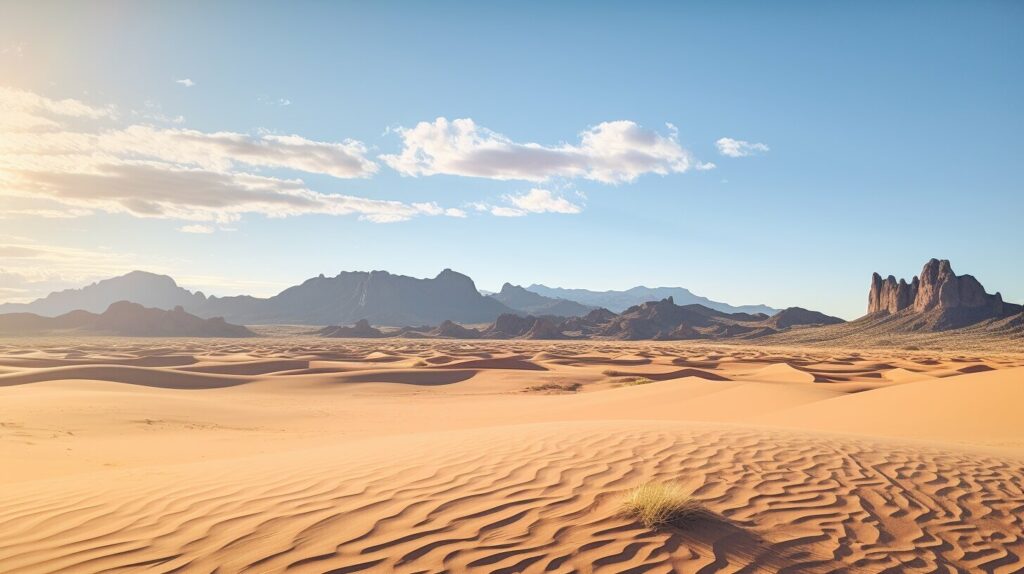
Moreover, the desert is also home to a variety of animal species, both harmful and beneficial. Snakes, scorpions, and spiders pose a danger to hikers, so it’s important to take precautions and be familiar with the signs of their presence. On the other hand, desert plants and animals can provide important resources, such as food and medicine, in a survival situation.
By understanding the unique characteristics of the desert environment, you’ll be better equipped to navigate through it safely and confidently.
Using Landmarks and Natural Navigation Cues
When navigating in the desert, landmarks and natural navigation cues are your best friends. They serve as reference points and can help you stay on track, even if you don’t have a compass or map.
One of the most useful landmarks in the desert is rock formations. They are usually easy to spot and provide a solid reference point. When using rock formations for navigation, try to pick out distinct features that you can easily identify, such as a spire or a unique shape. This will make it easier to spot the formation from a distance and stay on track.
Vegetation can also be a useful navigation cue, especially in areas where there is little else to go on. Look for hardy plants that can survive in arid environments, such as cacti or desert shrubs. These can often be used to indicate the direction of water sources or other important landmarks.
Using the Sun and Stars for Navigation
The sun and stars can also be used as natural navigation cues in the desert. During the day, the sun can be used to determine direction. Simply look at the sun and note its position in the sky. In the Northern Hemisphere, the sun is always in the south, so if the sun is directly overhead, you are headed south. If the sun is to your left, you are headed east, and if it is to your right, you are headed west.
At night, the stars can be used for navigation. The North Star, also known as Polaris, is always located in the northern sky and can be used as a reference point to determine north. Other constellations can also be used to determine direction, depending on the time of year and your location.

“Remember, navigation in the desert is all about paying attention to your surroundings and using what you have at your disposal.”
Using Wind Patterns for Navigation
Wind patterns can also be used for navigation in the desert. Sand dunes and other features are shaped by the wind, so by paying attention to their direction, you can determine the direction of the prevailing winds. This can be useful for predicting weather patterns and finding water sources, as the prevailing winds often bring moisture from nearby bodies of water.
Remember, navigation in the desert is all about paying attention to your surroundings and using what you have at your disposal. By mastering natural navigation cues, you can stay on track and avoid getting lost in the vast expanse of the desert.
Reading the Desert Terrain
When navigating in the desert, it’s crucial to be able to read the terrain to avoid potential hazards and determine the best path to your destination. Here are some techniques to help you navigate the desert terrain:
| Technique | Description |
|---|---|
| Scanning the horizon | Look for distinctive features in the distance, such as mountains or large rock formations, which can serve as landmarks and help you maintain your orientation. |
| Observing the ground | Pay attention to the color and texture of the ground, as well as any visible vegetation or animal tracks, to identify areas with potential water sources or obstacles. |
| Identifying wind patterns | Observe the movement of sand dunes and other small debris to determine the direction of prevailing winds. This can help you anticipate changes in weather and plan your route accordingly. |
Remember to always approach new terrain with caution and check for potential hazards, such as steep cliffs or areas with loose rocks, before proceeding. By mastering the skill of reading the desert terrain, you’ll be better equipped to navigate safely and efficiently in this challenging environment.
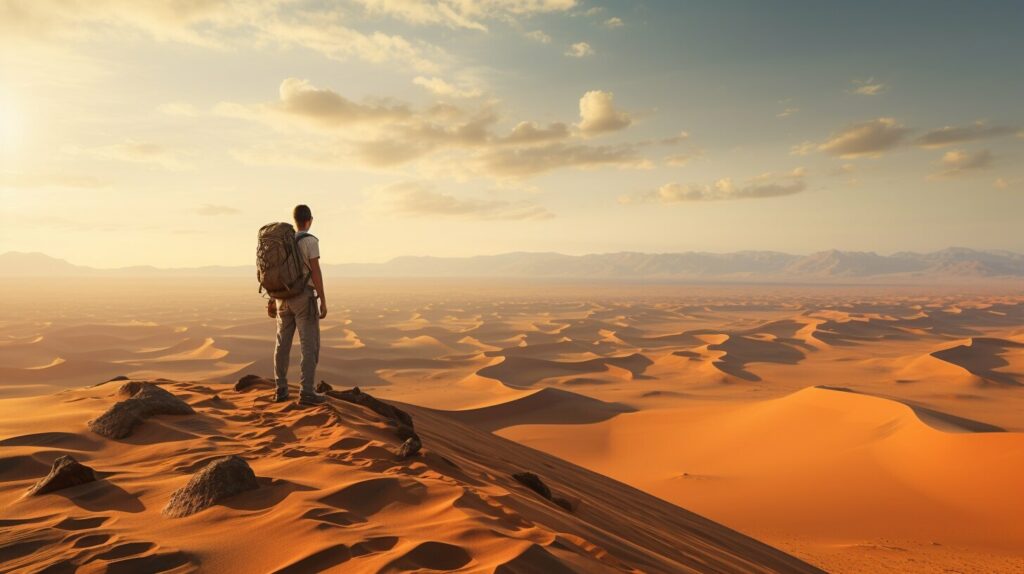
Navigating with Compass and Map
When it comes to navigating accurately in the desert, using a compass and map is a reliable method to find your way around. Remember to bring a compass that is designed for desert use and a detailed topographical map of your route.
To use a compass, hold it level and face towards north (magnetic or true, depending on the type of compass you have). Rotate the compass housing so that the direction of travel arrow aligns with your target destination, and then turn your entire body until the magnetic needle lines up with the orienting arrow in the housing. You are now facing your desired direction.
When using a map, orient it so that the top of the map is pointing towards north. Use the compass to take a bearing on a landmark in the distance, and then draw a straight line on the map from your current location to the landmark. Repeat the process for other landmarks along your route, and you’ll soon have a clear path to follow.
Remember to adjust for magnetic declination, which is the difference between true north and magnetic north. This will ensure that your compass readings are accurate and reliable.
While navigating with a compass and map can be a highly effective method, it’s important to have other navigation techniques in your toolkit in case you run into unexpected challenges or obstacles.
Desert Map Reading Tips
To make the most of your desert map reading skills, consider these helpful tips:
- Invest in a high-quality topographical map that shows features like elevation and terrain types.
- Use a clear ruler or straight edge to draw straight lines on your map.
- Mark your starting point and other key points on the map.
- Memorize notable landmarks and terrain features along your route.
- Don’t rely solely on your map – be aware of your surroundings, and use all of your senses to stay aware of potential hazards.
By mastering the art of using a compass and map, you’ll have a powerful tool at your disposal to help navigate the desert terrain and reach your destination safely.
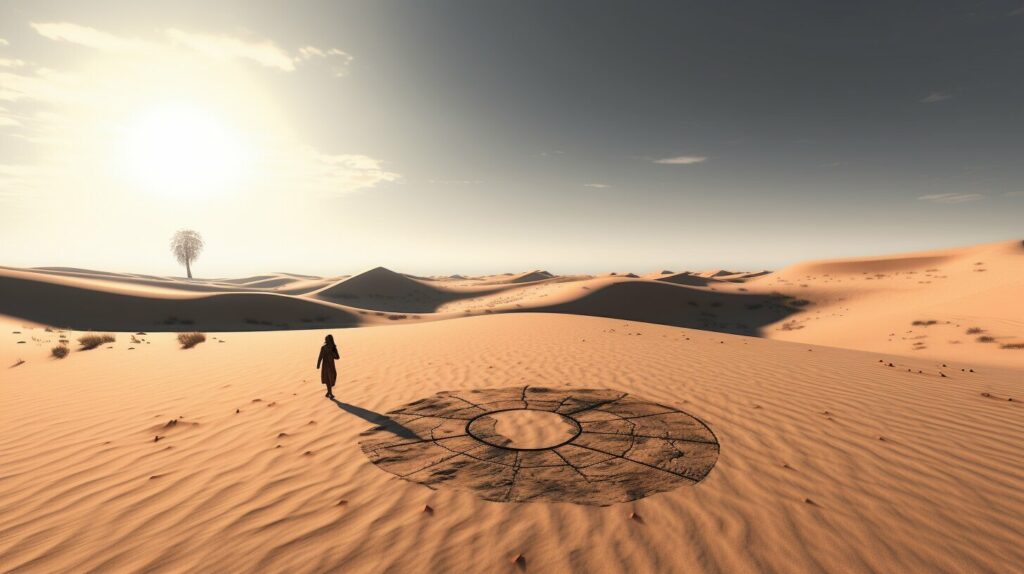
Essential Navigation Equipment for the Desert
When exploring the desert, it’s crucial to have the right equipment to ensure your safety and navigate with ease. Here are some essential navigation tools you should always have:
| Navigation Tool | Description |
|---|---|
| Compass | A compass is a must-have tool for desert navigation. It can help you determine your direction and follow a specific bearing. Make sure to choose a high-quality model that can withstand the extreme temperatures and terrain of the desert. |
| Maps | Carry detailed topographic maps of the area you’re exploring. These maps should have accurate information on terrain features, landmarks, water sources, and potential hazards. Keep them in a waterproof case to protect them from the elements. |
| GPS Device | A GPS device can help you determine your exact location and track your progress. However, don’t rely on it entirely as batteries can die, or technology can fail. Always have a backup navigation tool. |
| Sun Protection | Carry sunscreen, sunglasses, and a hat to protect yourself from the harsh UV rays of the sun. This will help prevent sunburn, dehydration, and other heat-related conditions that can affect your navigation and survival. |
| Emergency Signaling Tools | Always carry signaling tools such as a whistle, signal mirror, or flare gun. These will help you attract attention and call for help in case of an emergency. |
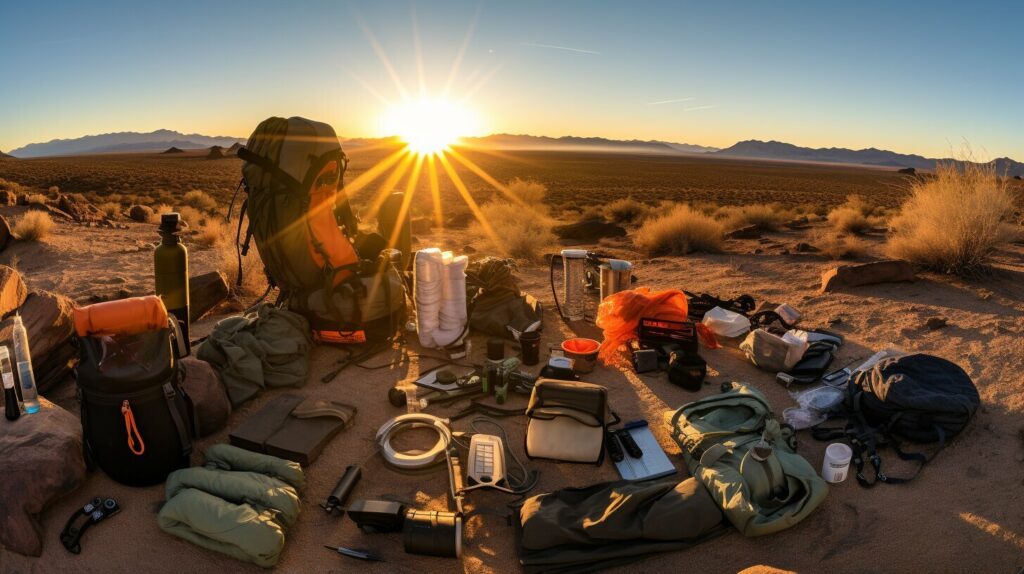
By having these essential navigation tools, you’ll be better equipped to handle the challenges of desert navigation and increase your chances of a safe and successful journey.
Planning Your Desert Route
When planning your route in the desert, it’s crucial to consider a variety of factors that can impact your journey. One of the most important considerations is distance, as it will determine how much water and supplies you need to carry. Additionally, you should take into account the type of terrain you’ll be covering and any potential hazards, such as steep canyons or areas prone to flash flooding.
Another important factor to consider when planning your desert route is water sources. Make sure you identify where you can find water along your route and factor in the time it will take to reach those sources. Remember that the availability of water can vary depending on the time of year and weather conditions.
It’s also important to assess your own physical abilities when planning your desert route. Be honest with yourself about your stamina, strength, and endurance, and plan your route accordingly. Make sure you give yourself plenty of time to rest and recharge, especially if you’re traveling alone.
Finally, always be prepared for unexpected changes in your route due to unforeseen circumstances. This could mean carrying extra supplies or being able to adjust your plans on the fly if necessary.
To help plan your route, check out this map of popular hiking trails and routes in some of the country’s best desert environments, including Death Valley and Joshua Tree National Parks:
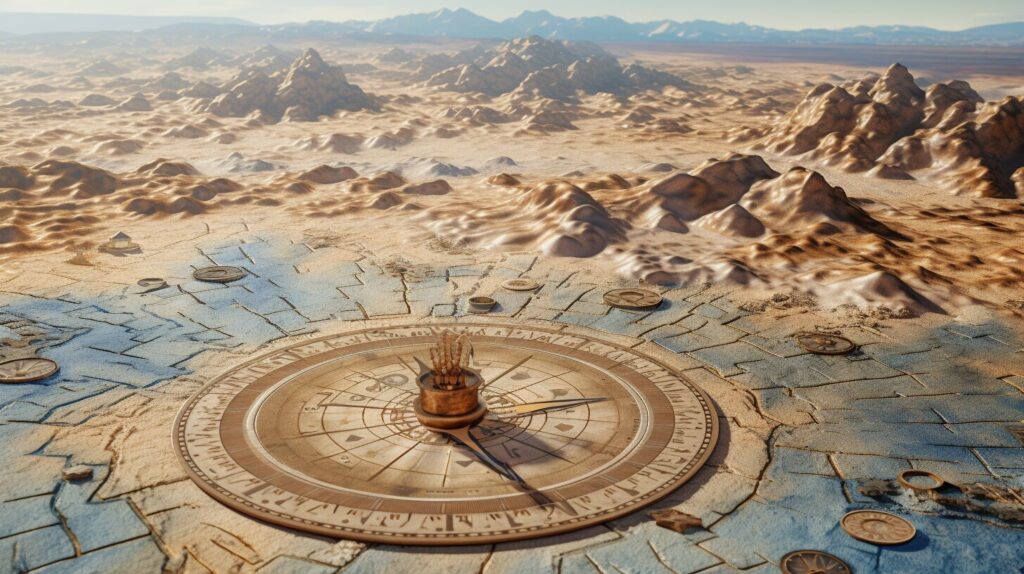
“Remember that no matter how well you plan, nature can be unpredictable. Always have a backup plan and be prepared to adjust your route as needed.”
Techniques for Maintaining Orientation
When navigating in the desert, it’s crucial to be able to maintain your orientation and stay on course. Here are some techniques you can use:
Celestial Navigation
One of the most reliable methods of navigation is by using the sun, moon, and stars. By observing their positions and movements, you can determine your direction and approximate time. To use the sun as a guide, find a straight object like a stick or a rock, and place it in the ground. Mark the end of the shadow with a rock or a stick, and wait for 10-15 minutes. Mark the new position of the shadow, and draw a line between the two points. This line will point east-west, with the first point being west, and the second point being east.
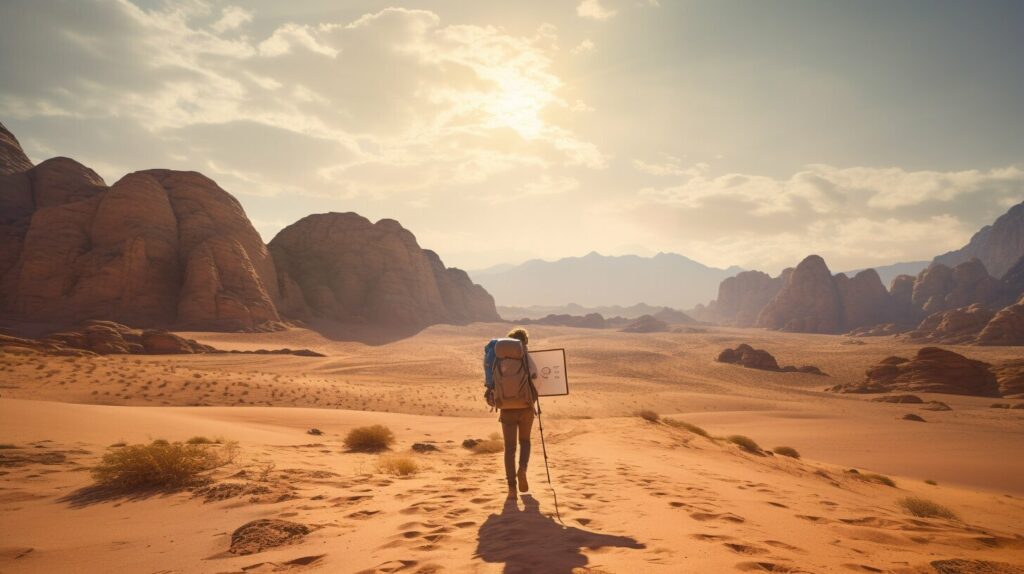
Shadow-Stick Method
This method can be used to determine direction and time. Place a stick upright in the ground and mark the end of the shadow with a rock or a stick. Wait for 30 minutes and mark the end of the new shadow. Draw a straight line between the two marks. The first mark indicates the west direction and the second the east direction. To determine the time – draw a line between the two marks, and divide this line into segments. Each segment represents 1 hour.
Natural Indicators
There are natural indicators in the desert that can help guide you, such as wind patterns and sand dunes. The wind generally blows from the west to the east during the day and from the east to the west at night. Sand dunes can indicate direction, with the steep side of the dune typically facing west.
These techniques can be helpful in maintaining your orientation when traveling through the desert. Remember that no single method is foolproof, and it’s best to use a combination of techniques to stay on course.
Navigating the Desert Terrain in Low Visibility Conditions
Low visibility conditions can strike unexpectedly in the desert, which can result in disorientation and confusion. It is important to be prepared with strategies for navigating in these situations.
Use sound and touch cues. In low visibility conditions, you may need to rely on your other senses to navigate. Listen for the sound of distant landmarks, such as a river or a highway, and use their direction to guide you. You can also feel the texture of the ground to determine if you are walking on sand or hard ground, which can help you maintain your bearings.
Use a compass. In low visibility conditions, a compass can be a lifesaver. Take regular compass readings to check your direction and ensure you are staying on course. Remember to adjust for magnetic declination if necessary.
Limit unnecessary movements. In low visibility conditions, it is easy to become disoriented and lose your sense of direction. To reduce the likelihood of this happening, limit unnecessary movements and stick to your planned route as closely as possible.

Remember, the best strategy for navigating in low visibility conditions is to be prepared. Carry a compass and map, and have a clear understanding of your route before setting out. By taking these steps, you can safely navigate through the desert, even in the most challenging conditions.
Tracking and Backtracking Techniques:
Getting lost in the desert can be a terrifying experience, but with proper tracking and backtracking techniques, you can retrace your steps and find your way back to safety. Here are some essential tracking and backtracking tips:
- Mark your trail: Before you set off, mark your trail periodically with rocks or other easily visible objects. This will help you retrace your steps if you get lost.
- Pay attention to surroundings: As you travel, take note of important landmarks, such as distinctive rock formations or vegetation. These can help you recognize where you are and where you need to go.
- Track your footprints: If you lose your trail, track your own footprints backward using a stick or other tool to avoid stepping on them. This will lead you back to where you started.
- Use a compass: A compass is an essential tool for backtracking. Take a bearing before you leave and use it to guide you back to your starting point.
- Take frequent breaks: Resting periodically allows you to stop, observe your surroundings, and assess your progress. This also gives you time to retrace your steps if you need to.
Remember: if you do get lost, stay calm and assess your situation. Use your tracking and backtracking techniques to retrace your steps and find your way back to safety.
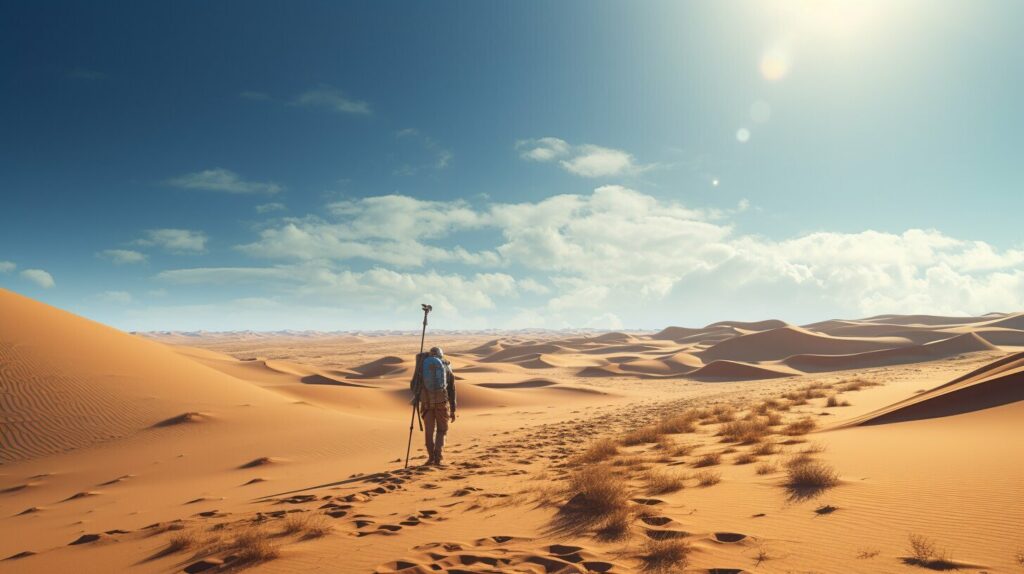
Navigation Tips for Desert Travelers
When traveling in the desert, it is important to stay on course and avoid getting lost. Here are some additional tips to help you navigate successfully:
- Use your pace count: Keep track of how many steps it takes you to walk a certain distance, such as 100 yards. This can help you estimate how far you’ve traveled and how much farther you need to go.
- Conserve energy: Travel in the cooler parts of the day, take breaks in shaded areas, and avoid overexertion. This will help you conserve energy and avoid dehydration.
- Stay hydrated: Carry plenty of water with you, and drink regularly even if you don’t feel thirsty. Dehydration can impair your judgment and physical abilities.
- Keep a positive attitude: Navigating in the desert can be challenging and stressful, but try to stay calm and focused. A positive attitude can help you stay motivated and make good decisions.
- Bring a backup navigation method: Even if you’re confident in your navigation skills, it’s always a good idea to bring a backup method such as a GPS device or satellite phone.
Remember, mastering desert navigation takes practice and experience. Don’t be afraid to start small and build your skills gradually. With the right techniques and equipment, you can safely explore the beauty and challenges of the desert.

Conclusion
You have now learned the essential techniques for mastering desert navigation. Remember, navigating in arid terrain can be extremely challenging and even life-threatening if you are not adequately prepared.
By understanding the unique features of the desert environment and using natural navigation cues, you can confidently navigate through the sand and rocks. Mapping skills, compass reading, and other navigation equipment are indispensable tools for safe travel in the desert.
Always plan your route carefully, taking into consideration factors such as distance, terrain, water sources, and potential hazards. And, in case you get lost, tracking and backtracking techniques will help you find your way back.
Final Thoughts
Remember to keep hydrated and maintain an appropriate pace to conserve your energy. And, if you encounter low visibility conditions or other obstacles, stay calm and use the techniques you have learned to navigate through them.
With the knowledge and skills you have gained from this article, you can confidently navigate through the desert and ensure your survival. Happy travels!
FAQ
Q: What are desert navigation techniques?
A: Desert navigation techniques are strategies and skills used to navigate through arid terrains, such as deserts, to reach a destination safely. These techniques involve using landmarks, natural navigation cues, compasses, maps, and other essential equipment.
Q: Why is mastering desert navigation techniques important?
A: Mastering desert navigation techniques is crucial for survival in arid environments. Without proper navigation skills, individuals can easily become lost, disoriented, and put themselves at risk of dehydration, exhaustion, and other potential hazards. Knowing how to read the terrain, use landmarks, and navigate accurately with a compass and map can greatly increase your chances of reaching safety.
Q: What are some natural navigation cues in the desert?
A: Natural navigation cues in the desert include rock formations, vegetation patterns, wind patterns, and the position of the sun and stars. These cues can be used as reference points to help maintain direction and navigate through the desert.
Q: How can I read the desert terrain?
A: Reading the desert terrain involves observing and interpreting various features, such as sand dunes, rock formations, vegetation, and animal tracks. By analyzing these elements, you can determine the best path to take, avoid potential hazards, and find water sources if necessary.
Q: How do I use a compass and map for desert navigation?
A: To use a compass and map for desert navigation, you first need to orient the map according to the compass’s magnetic north. Then, you can determine your current location and desired destination on the map, take bearings using the compass, and follow a specific route to reach your destination accurately.
Q: What essential navigation equipment do I need for the desert?
A: Essential navigation equipment for the desert includes a reliable compass, detailed maps of the area, a GPS device, emergency signaling tools (such as a whistle or mirror), and a watch for measuring time and maintaining pace. It is also recommended to carry a backup compass and extra batteries for your electronic devices.
Q: How do I plan a desert route?
A: When planning a desert route, consider factors such as the distance you need to cover, the terrain’s difficulty, availability of water sources, potential hazards (such as steep slopes or dense vegetation), and any landmarks or natural navigation cues that can assist you. Careful planning will help ensure a safer and more efficient journey.
Q: How can I maintain orientation in the desert wilderness?
A: To maintain orientation in the desert wilderness, you can use celestial navigation techniques by identifying the positions of the sun, moon, and stars. Additionally, shadow-stick methods, where you mark the movement of a shadow over time, and paying attention to other natural indicators, such as wind direction and animal behavior, can also help you stay oriented.
Q: What should I do in low visibility conditions in the desert?
A: In low visibility conditions, such as sandstorms or darkness, it is crucial to rely on your senses other than sight. Use sound cues, such as the direction and intensity of the wind, and touch cues, such as feeling the texture of the ground or nearby objects, to help maintain your sense of direction and navigate safely.
Q: How can I track and backtrack in the desert?
A: Tracking and backtracking techniques involve closely observing your surroundings, including footprints, vehicle tracks, or any other signs left by yourself or others. By retracing your steps and following these signs, you can navigate back to a known point or find your way back if you become lost in the desert.
Q: What are some additional navigation tips for desert travelers?
A: Additional navigation tips for desert travelers include maintaining a pace count to track distance covered, conserving energy by traveling during cooler parts of the day, and staying hydrated by drinking water regularly. It is also important to be familiar with basic first aid skills and carry a well-stocked survival kit.

